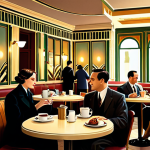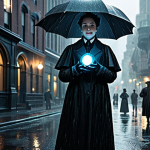Ever felt like time itself was playing tricks on you? Reverse: 1999 plunges you into a world where the Roaring Twenties are being, well, *un-roared*. Imagine the champagne bubbles deflating, jazz records spinning backward, and reality rewriting itself piece by piece.
You play as Vertin, a Timekeeper tasked with understanding and potentially reversing this temporal anomaly. It’s a thrilling blend of historical mystery, supernatural intrigue, and card-based combat that keeps you guessing at every turn.
The aesthetics alone are enough to draw you in – think Art Deco meets eldritch horror. Personally, diving into this game felt like stepping into a stylish, slightly unsettling dream.
Let’s get a deeper look in the article below.
Unraveling the Enigmatic Characters of Reverse: 1999

Reverse: 1999 isn’t just about bizarre temporal shifts; it’s populated by a cast of compelling characters, each with their own secrets and motivations.
Vertin, the protagonist, is a stoic and determined Timekeeper, navigating the chaos with a blend of curiosity and caution. Then there’s Sonetto, Vertin’s steadfast companion, whose knowledge of the arcane proves invaluable.
What truly hooked me was how these characters reacted to the ever-changing world around them. I remember one scene where Vertin and Sonetto had to improvise a solution when their usual methods were rendered useless by a particularly aggressive time distortion.
It was their quick thinking and trust in each other that saved the day, and it really cemented my investment in their journey. The antagonists are equally intriguing, shrouded in mystery and possessing powers that defy easy explanation.
Unraveling their goals and understanding their connections to the temporal anomalies became a driving force in my gameplay. It wasn’t just about winning battles; it was about piecing together the puzzle of their existence.
1. Delving into Vertin’s Unique Abilities
Vertin’s abilities as a Timekeeper are central to the gameplay and story. She possesses the power to “revise” events, essentially rewinding time on a small scale to correct mistakes or gain an advantage in combat.
I found this mechanic to be incredibly satisfying, as it allowed for strategic experimentation and the chance to undo costly errors. Her power isn’t unlimited though.
She needs to consider multiple factors before using the power. Vertin also uses a suitcase that is actually a device that helps her travel through time.
2. Discovering Sonetto’s Arcane Expertise
Sonetto’s expertise in arcane knowledge provides crucial support to Vertin. She is very helpful on how to identify and counter the various anomalies they encounter.
Her character development is quite interesting, as she slowly begins to question the Timekeepers’ methods and consider alternative solutions. One thing I noticed is that she is very meticulous in her work.
3. Decoding the Motivations of the Antagonists
The antagonists in Reverse: 1999 are not simply villains; they are complex characters with their own motivations and agendas. Some seek to control the power of the temporal anomalies for their own gain, while others believe they are acting in the best interests of the world.
I think the thing that makes the villains interesting is that they all have different beliefs and values.
Exploring the Card-Based Combat System
The combat system in Reverse: 1999 is a unique blend of card battling and turn-based strategy. Each character has a set of cards representing their skills and abilities, and players must strategically combine these cards to unleash powerful attacks and defensive maneuvers.
I initially found the system a bit daunting, but after a few battles, I began to appreciate its depth and flexibility. Experimenting with different card combinations and character synergies became a rewarding experience.
The game encourages strategic thinking and rewards players who can adapt to different combat scenarios. I liked that the cards aren’t just about raw power; they often have secondary effects that can turn the tide of battle.
1. Mastering Card Combinations for Maximum Impact
The key to success in Reverse: 1999’s combat system lies in mastering card combinations. Certain cards, when played together, create powerful synergies that amplify their effects.
For example, combining an attack card with a buff card can significantly increase damage output. I found myself constantly experimenting with different combinations to discover the most effective strategies.
Sometimes, the best combos aren’t immediately obvious, and it takes a bit of trial and error to uncover them. Don’t forget that you can upgrade each card to make them even stronger.
2. Utilizing Character Synergies for Strategic Advantage
Each character in Reverse: 1999 has unique skills and abilities that complement each other. By building a team with strong synergies, players can create devastating combinations that can overwhelm even the toughest enemies.
For example, a character with healing abilities can keep the team alive while damage dealers unleash their attacks. I tried to build a team that has different skills so that they can respond to different scenarios.
It is like a rock-paper-scissors game.
3. Adapting to Different Combat Scenarios
Reverse: 1999 throws a variety of combat scenarios at players, each with its own challenges and strategic considerations. Some battles require a more defensive approach, while others demand aggressive tactics.
Players must be able to adapt their strategies to the specific circumstances of each encounter. Sometimes, you may want to use specific character based on the enemy type.
Immersing Yourself in the Art Deco Aesthetic
The visual style of Reverse: 1999 is a standout feature, blending Art Deco elegance with elements of supernatural horror. The character designs are stylish and distinctive, the environments are atmospheric and detailed, and the overall aesthetic creates a sense of both beauty and unease.
I was immediately drawn to the game’s visual presentation. The Art Deco influence is evident in everything from the character outfits to the architecture of the buildings.
The color palettes are rich and vibrant, and the lighting effects create a sense of depth and atmosphere. It’s a world that feels both familiar and otherworldly, a perfect complement to the game’s themes of temporal distortion and supernatural mystery.
1. Appreciating the Stylish Character Designs
The character designs in Reverse: 1999 are a masterclass in visual storytelling. Each character’s appearance reflects their personality, background, and role in the story.
Vertin’s stoic demeanor is reflected in her tailored suit and no-nonsense hairstyle, while Sonetto’s arcane expertise is conveyed through her flowing robes and mystical accessories.
I always make sure to check each character’s background story.
2. Exploring the Atmospheric Environments
The environments in Reverse: 1999 are as much a part of the story as the characters themselves. Each location is meticulously crafted to evoke a specific mood and atmosphere.
From the opulent ballrooms of the Roaring Twenties to the eerie depths of forgotten ruins, every environment tells a story. The team did a great job in designing the visual environments.
3. Discovering the Hidden Details
Reverse: 1999 is packed with hidden details that reward attentive players. From subtle visual cues to cryptic messages, the game encourages players to explore every nook and cranny of its world.
One thing I like to do is try to find Easter eggs in the game.
The Intriguing Time Travel Mechanics
At its core, Reverse: 1999 hinges on the concept of time travel. The Timekeepers are tasked with investigating temporal anomalies, and their ability to manipulate time forms the basis of both the narrative and the gameplay.
It’s not about hopping around willy-nilly; there are rules and consequences to every temporal shift. I was captivated by the way the game explores the paradoxes and potential dangers of messing with the past.
The Timekeepers aren’t just correcting errors; they’re walking a tightrope between preserving history and preventing catastrophic consequences.
1. The Paradoxes and Potential Dangers of Messing With Time
Reverse: 1999 delves into the complexities of time travel, exploring the potential paradoxes and dangers that can arise from altering the past. The Timekeepers must be careful not to create unintended consequences or disrupt the flow of time.
They also need to be aware of the risks of getting stuck in a time loop.
2. Balancing Preserving History and Preventing Catastrophic Consequences
The Timekeepers must strike a delicate balance between preserving history and preventing catastrophic consequences. They cannot simply erase events that they don’t like; they must carefully consider the potential ramifications of their actions.
Each time they travel to the past, they need to be very careful.
3. Navigating the Temporal Anomalies
Temporal anomalies are the primary threat in Reverse: 1999. These unpredictable events can distort reality, create time loops, and unleash powerful enemies.
The Timekeepers must use their abilities to understand and contain these anomalies before they can cause irreparable damage. Each anomaly is different and they need to come up with different strategies to tackle them.
The Allure of the Supernatural
Beyond the historical setting and time travel elements, Reverse: 1999 incorporates a strong element of the supernatural. Magic, monsters, and otherworldly forces play a significant role in the story, adding another layer of intrigue to the world.
I’ve always been a sucker for stories that blend the mundane with the magical, and Reverse: 1999 delivers on that front. The supernatural elements aren’t just window dressing; they’re deeply intertwined with the themes of time, memory, and reality.
Discovering the origins of the magic and understanding the nature of the otherworldly creatures became a central part of my enjoyment.
1. Unveiling the Magic System
The magic system in Reverse: 1999 is intricate and mysterious, with different characters wielding different types of arcane powers. The Timekeepers use magic to manipulate time, while other characters possess abilities that defy explanation.
I was very interested in learning more about the magic system.
2. Battling the Monsters and Otherworldly Forces
Reverse: 1999 pits players against a variety of monsters and otherworldly forces, each with its own unique abilities and weaknesses. Players must use their strategic skills and arcane knowledge to overcome these challenges.
The character designs are scary, yet unique.
3. The Connection between Magic, Time, Memory, and Reality
Reverse: 1999 explores the complex connection between magic, time, memory, and reality. The game suggests that these concepts are intertwined and that manipulating one can have profound effects on the others.
It makes you think a lot about how time flows.
Monetization Aspects in Reverse: 1999
Reverse: 1999, like many gacha games, employs various monetization strategies to generate revenue. These often involve in-app purchases for premium currency, which can be used to acquire new characters, items, or speed up progression.
Understanding these elements can help players make informed decisions about their spending habits. As a player, I am always wary of games that are too aggressive with their monetization.
It’s important to find a balance between supporting the developers and enjoying the game without feeling pressured to spend money. I like it when I can progress without having to spend too much money.
Here’s a table summarizing the key monetization aspects of Reverse: 1999:
| Monetization Aspect | Description | Player Impact |
|---|---|---|
| Gacha System | Randomized character acquisition using in-game currency or premium currency. | Determines the difficulty of obtaining specific characters; can lead to frustration or satisfaction depending on luck. |
| Premium Currency | Purchased with real money; used for gacha pulls, item purchases, and speeding up timers. | Provides a faster progression route for paying players. |
| Battle Pass | Offers tiered rewards for completing daily and weekly challenges; often includes premium currency and exclusive items. | Incentivizes regular play and rewards players who engage with the game consistently. |
| Limited-Time Events | Offer exclusive characters, items, and storylines; often tied to special gacha banners. | Creates a sense of urgency and encourages players to spend resources to acquire limited-time content. |
| Cosmetic Items | Allow players to customize their characters’ appearance; often sold for premium currency. | Appeals to players who value customization and self-expression. |
1. Examining the Gacha System and its Impact on Gameplay
The gacha system is a core element of Reverse: 1999’s monetization strategy. Players spend in-game currency or premium currency to “pull” for random characters, items, or other rewards.
The odds of obtaining specific items are often low, leading to a sense of gambling and potential frustration. I tried to limit my spending and make the most of the free resources the game provides.
I found that I can still progress even if I don’t spend money.
2. Evaluating the Value of Premium Currency and In-App Purchases
Premium currency in Reverse: 1999 can be used for a variety of purposes, including gacha pulls, item purchases, and speeding up timers. Players must carefully evaluate the value of these purchases and determine whether they align with their goals and budget.
It is very important to think carefully before you spend money.
3. Balancing Free-to-Play Progression and Paid Advantages
Reverse: 1999 is designed to be playable without spending money, but the game also offers advantages to paying players. Free-to-play players may need to grind more, manage their resources carefully, and rely on luck to progress, while paying players can accelerate their progress with premium currency and in-app purchases.
It is still fun even without spending money.
Tips and Tricks for Mastering Reverse: 1999
Reverse: 1999 can be a challenging game, but with the right strategies and knowledge, players can overcome any obstacle. Here are a few tips and tricks to help you master the game:* Understand the elements: Each character and enemy has an elemental affinity, and exploiting these weaknesses is crucial for success.
* Build a balanced team: A well-rounded team should include characters with different roles, such as damage dealers, healers, and support units. * Master the card * Complete daily and weekly challenges: These challenges offer valuable rewards that can help you progress faster.
* Join a community: Connect with other players online to share tips, strategies, and experiences.
1. Understanding Character Synergies
Understanding character synergies is very important. If you understand the character synergy, you can make them a strong team. Every character has their strengths and weaknesses.
2. Upgrading Cards
Upgrading cards is essential to make them even stronger. Don’t forget to upgrade them because it can help you progress a lot.
3. Completing Daily and Weekly Quests
Daily and weekly quests can offer you many rewards that you don’t want to miss. Make sure you check them out every day. Unraveling the intricacies of Reverse: 1999 has been an absolute blast!
The blend of time-traveling mysteries, strategic card battles, and stunning Art Deco visuals makes it a truly unique and captivating game. I hope this exploration has sparked your interest and provided some helpful insights for your own journey through the ever-shifting timelines.
Now, go forth and bend time to your will!
Wrapping Up
Reverse: 1999 offers a unique gaming experience with its captivating storyline and strategic gameplay. It is a world that keeps you engaged and eager to discover what unfolds next. There are tons of reasons why you should play this game.
From the art style to the unique gameplay, it can keep you playing for hours and hours.
So, what are you waiting for? Download the game and give it a try now!
Handy Tips & Tricks
1. Always check the elemental affinities before heading into a battle. It can drastically change the battle outcome.
2. Don’t just focus on damage; a balanced team with healing and support is key for long-term success.
3. Experiment with card combinations to unleash devastating synergies.
4. Claim your daily and weekly rewards religiously – they are vital for progression.
5. Join the Reverse: 1999 community and share your strategies with others. You can learn a lot of information.
Key Takeaways
Reverse: 1999 blends time travel, card-based combat, and Art Deco visuals into a compelling gaming experience.
Mastering card combinations and character synergies is essential for strategic success.
The game offers a balance between free-to-play progression and paid advantages, so players can enjoy the game regardless of their spending habits.
Understanding the monetization aspects of the game can help players make informed decisions about their spending habits.
There are many things that can keep you playing for hours and hours so give it a shot!
Frequently Asked Questions (FAQ) 📖
Q: Is “Reverse: 1999” a free-to-play game?
A: Yeah, “Reverse: 1999” is free-to-play, but like many gacha games, it offers in-app purchases. I’ve played a bit without spending a dime, and you can definitely progress, but those shiny new characters and resources can tempt you to open your wallet.
It all comes down to your patience and how much you want to speed things up.
Q: What’s the gameplay actually like? Is it just another typical card battler?
A: Honestly, I was expecting a generic card game, but “Reverse: 1999” throws in some neat twists. You’re collecting and upgrading characters, but the card-based combat has this strategic layer where you can merge cards for stronger attacks or save them for later.
It’s not groundbreaking, but the unique character abilities and the narrative woven into battles kept me engaged more than I thought it would. Plus, the animations during special attacks are seriously stylish.
Q: I’m terrible at gacha games. Is “Reverse: 1999” beginner-friendly, or will I be completely lost?
A: I’d say it’s relatively beginner-friendly. The initial tutorials are actually pretty good at explaining the basics, and you’re not immediately overwhelmed with a million different currencies and systems.
There’s definitely a learning curve as you dive deeper, but the game does a decent job of gradually introducing new mechanics. Just be prepared to read a lot of ability descriptions, and don’t be afraid to look up a guide or two if you get stuck.
I needed some help figuring out team comps, that’s for sure!
📚 References
Wikipedia Encyclopedia
구글 검색 결과
구글 검색 결과
구글 검색 결과
구글 검색 결과
구글 검색 결과






